Archaeologists and preservationists are discovering and conserving deep human history at a site that is reshaping our understanding of the first whispers of early civilization. This article originally appeared on Popular Archaeology.

“This is the first human-built holy place,” Klaus Schmidt, the late director of excavation at Göbekli Tepe, once said of the ancient Anatolian site. It is a powerful statement, but belying the grandiose imagery is the reality on the ground.
Called “Potbelly Hill” by locals for its gently sloping curves, the tawny promontory of Göbekli Tepe was a place of little note for thousands of years compared to its more illustrious neighbor, the city of Urfa. Believed by pious Muslims to be the Ur of the Chaldaeans and thus the birthplace of the patriarch Abraham, the geography of Urfa is pregnant with Biblical imagery. A large fishpond serves as a refreshing gathering spot today, but in local lore, it is the place where King Nimrod attempted to burn Abraham on a pyre. His plan was foiled when God turned the fire to water and the coals to fish, and it is believed they remain in place as a reminder of this early miracle and a testament to the power of faith. Göbekli Tepe, by contrast, had been used for agriculture and the pasturing of sheep.
And yet, the tawny earth of the mountaintop has long concealed a secret far older than Urfa, Ur, Nimrod, or Abraham: a ritual site of monumental design, built 6,500 years before the Great Pyramids of Egypt saw their first dawn. From the top of the hill on down, monolithic T-shaped limestone pillars, of variable weight and up to 20 feet in height, were installed into and supported by building walls or inserted into stone pedestals in the ground and supported, perhaps by roofs. Each monolith is carved with reliefs that ranged from the earliest depiction of an individual human ever discovered to dangerous animals, such as carrion birds or jaguars, to pictograms and, perhaps, sacred symbols. Hundreds of them exist, though only five percent of the site has been excavated and much work remains to be done.
The majesty of the site lies not just in its age and complexity. In its refutation of the received wisdom on the origins of civilization, there may be found a new history more mysterious and exciting than that charted before. Before Göbekli Tepe’s significance was discovered, archaeologists believed that the social conditions that prevailed with the emergence of agriculture, namely the division of labor, hierarchical societies, and increasing urbanization, birthed the first religions, which existed in part to legitimize the social order and provide it with a suitable metaphysical foundation. Only then, with the settling effects of village life firmly in place, did the earliest civilizations begin to construct the first humble temples and, when their might waxed greater, the first massive temple complexes. Hunter-gatherers, by contrast, lacked the ability to construct anything much more complicated than a lean-to.
After Göbekli Tepe, however, that wisdom was shown to be, if not wrong, at least wrongheaded.
The transition from Paleolithic to Neolithic lifeways was actually much messier than earlier histories have argued, for the storage of goods and the practice of sedentism, the settled life of non-nomadic peoples, arose in the Epipaleolithic among the Natufian people circa 9,500 BC. Around the same time, circa 8,200 BC, genetic changes have been observed in crop plants indicating their domestication. All these new developments, pre-agricultural though characteristic of the agricultural revolution in nature, took place in the Levant during the construction of Göbekli Tepe, highlighting the ferment of innovation surrounding its rise.
The remarkably early date of Göbekli Tepe’s construction, before the mass advent of agriculture and in the liminal period between man’s condition as a hunter-gatherer and as a settled farmer, suggests that the social pressures of agricultural society did not provide the rationale for ritualistic practices. These new practices themselves provided the grounds for a pre-agricultural, hunter–gatherer culture to band together, divide their labor, procure a steady source of food, and erect a megalithic site of proportions so epic they would not be matched anywhere for several thousand years – all without the use of writing, advanced tools, or even the wheel.

The location of Göbekli Tepe in relation to its surrounding geography and nearby Urfa. Wikimedia Commons
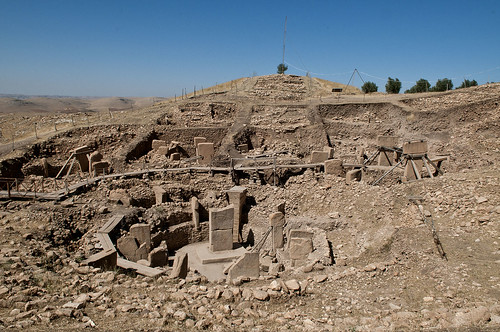
The ancient remains of Göbekli Tepe. Teo Mancimit, Wikimedia Commons
History of the Site
Göbekli Tepe’s significance was not realized right away, for when a joint American–Turkish survey expedition arrived at the top in the 1960s, their discovery of worked limestone and flint artifacts did not arouse any suspicion of the site’s significance or antiquity. Although they recognized it as a pre-historic site, their subsequent field report offered no clues as to its monumental construction. That laid beneath the ground, awaiting discovery.
This was an advantageous state of affairs for the late Klaus Schmidt, the excavator and site director for the German Archaeological Institute’s project at Göbekli Tepe in collaboration with the Museum of Sanliurfa and the Turkish Ministry of Culture. After following the American team’s field notes to the top of the promontory, Schmidt recalls seeing what he deemed a Neolithic-era quarry and flint and limestone scattered everywhere. Instantly, he knew the value of what he saw. “In one minute – in one second – it was clear” he says. For 20 years, Schmidt dedicated his life to excavating the site in the quest to reveal its many hidden secrets.

Göbekli Tepe is astounding for the complexity and majesty of its design, and until excavations began, a complex of this scale was not thought possible for a community so ancient. Explaining the purpose of the site has been paramount for the researchers working there, and the hypotheses have evolved over time.
Prof. Schmidt did not believe Göbekli Tepe to have been a settlement, despite its antiquity and baffling complexity. He based his opinion on the paucity of evidence for residential buildings or fortifications of any kind – other than those housing the monolithic T-shaped pillars – as well as the lack of evidence that settlers cultivated the nearby land. Due to the remoteness of the site, he believed Göbekli Tepe was instead a sanctuary and regional pilgrimage center where communities met to engage in rites from up to 60 miles away. The myriad butchered animal bones found at the site indicate a lively industry for hunting, preparing, and feeding these congregants, and may have been used for any sacrificial functions as well.
(Image right: Göbekli Tepe by night, by Nico Becker)
As work has progressed at the site, however, new evidence has shown that this hypothesis may not be correct. Contrary to the claims of the late Prof. Schmidt, Dr. Lee Clare, the current director of excavation at Göbekli Tepe, explains it is becoming increasingly clear that Göbekli Tepe supported at least a semi-sedentary population from its inception. The discovery of animal bones thus only confirms the presence of a community at Göbekli Tepe, as there has yet to be found any corroborating evidence of a sacrificial purpose. Indeed, their presence in the buildings may not indicate a ritual purpose at all but, instead, the wholly secular subsidence of nearby refuse piled into the buildings over time.
Göbekli Tepe Over Time: An Evolution in Thought
The evolution of thought on Göbekli Tepe’s origins and purpose has also impacted the understanding of its chronology. Prof. Schmidt argued the hill was built in three phases over a 2,000-year period beginning in the 10th millennium BC, which he labeled strata I, II, and III. The monumental ovoid or circular buildings were built in stratum III, being the deepest and earliest workings on the site; stratum II consisted of smaller, rectangular-shaped buildings with smaller T-shaped pillars; and stratum I was a transitory period when the older buildings were ritually backfilled with up to 650 cubic yards of refuse, including limestone fragments, animal and human bones, and discarded tools, marking the end of Göbekli Tepe’s cultic significance.
This is no longer an accurate picture, however, as new results obtained from the field show, first, that the monumental buildings, which Prof. Schmidt argued were part of the site’s earliest period—stratum III—were still in use during stratum II. This new insight alone has rendered the old stratigraphic hypothesis obsolete. Second, it is doubtful whether the backfilling of the buildings was ritualistic at all; it may instead reflect a more pedestrian cause, such as the erosion of midden piles from a higher point on the slope, an entirely unintentional consequence of natural processes rather than an intentional ritualized act. Third, later rectangular buildings were constructed over some of the filled buildings, further undercutting the clean chronology depicted in the strata I-III hypothesis.
T-Shaped Pillars
Göbekli Tepe’s earliest period saw the installation of approximately 170 T-shaped monoliths ranging in size from seven to 20 feet in height into the bedrock of the hill and the walls or roofs of the site’s circular, ovoid, or rectangular enclosures. The monoliths were cut from nearby limestone quarries and transported by hand to the hewn-out bedrock where they would be erected. Reliefs were also likely made at that time. According to one interpretation, the monolith is an abstract representation of the human form, with arms, hands, legs, loin cloths, belts, and other human accoutrements carved in low relief. These may have represented individuals, stylized humans, or incipient deities.
Many monoliths are adorned with intricate reliefs of totem animals, such as leopards, vultures, eagles, wild boar, scorpions, spiders, and snakes. The diversity of animal life depicted on the monoliths is indicative of their antiquity, for the region is believed to have been much more lush during the Neolithic era, when the land was a steppe-like environment of wild grasses dotted with small copses of pistachio, almond, and oak trees. By contrast, today’s region around Göbekli Tepe can best be thought of as a cultural landscape heavily influenced by farming and animal husbandry. Other pillars display pictograms that may be sacred symbols. All create a rich and intriguing iconography conducive to stimulating interpretations.
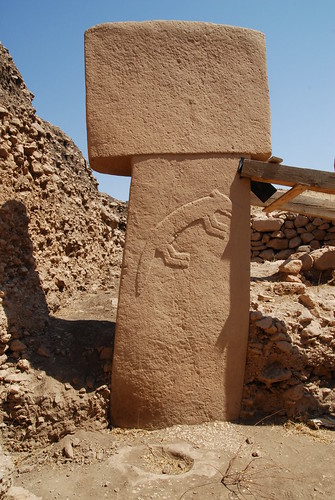
A T-shaped pillar with modern supports. Courtesy Klaus Schmidt
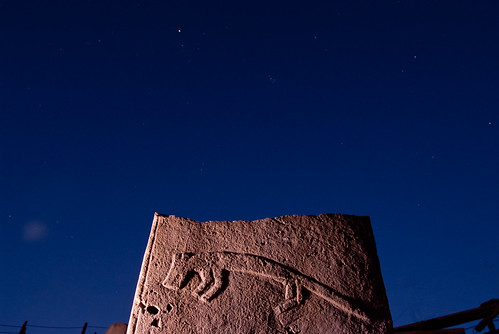
A pillar with a low-relief carving at night. Courtesy Nico Becker

An animal represented in stone, found at Göbekli Tepe. Courtesy Nico Becker
Göbekli Tepe’s Buildings
The T-shaped pillars provide the biggest draw to the site, but how they are arranged sheds light on the chronology and development of the site itself. The excavation team has discovered the existence of nearly 10 structures scattered throughout the site, which they named A through H in order of their discovery. Buildings A, B, C, D, and G were all discovered in Göbekli Tepe’s main excavation area, Building E is in the site’s western plateau area, Building F at the southwestern quadrant of the site, and Building H in the northwestern quadrant.
Of these structures, Building D is the best preserved of all known buildings in the site’s archaeological zone. It has the following form: 12 T-shaped pillars form a circle around two larger, central pillars measuring approximately 20 feet in height. Carved out of limestone from the nearby quarry and inserted into pedestals hewn from Göbekli Tepe’s own bedrock, these pillars are frequently blank but are sometimes adorned with reliefs of local animals, including foxes, cranes, storks, ducks, snakes, boar, aurochs, gazelle, and wild donkeys.
This is not to say that Building D is the definitive type, however, as there exists a variety of architectural styles ranging from circular to ovoid and rectangular, some of which are transitional between the two. Building C, for example, was built in three concentric rings, one within the other, reflecting different periods of use. Whether the denizens of Göbekli Tepe would fill in the outer rings with material before building newer, smaller ones within it or if the filling was, as stated above, an unintentional process of erosion, is not fully clear.
Excavations of Buildings A and G show a more transitional-rectangular shape. Doorless and windowless and with floors of polished lime, these were likely the cellars of multi-story buildings that have since collapsed. If families lived in the buildings, as the semi-sedentary hypothesis suggests, they would have conducted much of their business from the roof, and the entrances likely would have been located there as well. Like the monumental enclosures that preceded them, these rectangular buildings also served as sanctuaries for T-shaped pillars which, though smaller than their predecessors – these pillars never reached higher than seven feet tall – were placed in the center of the cellars where they could be given the greatest prominence.
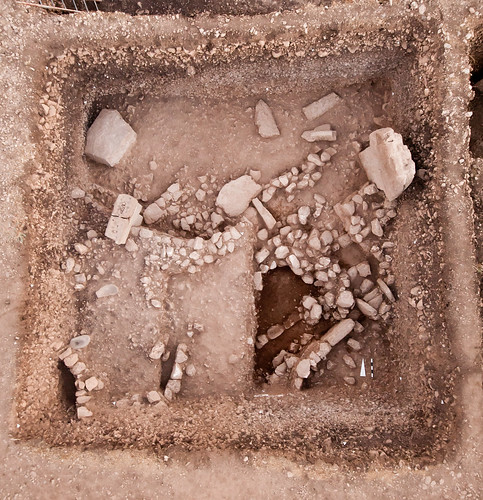
One of the rectangular structures unearthed at Göbekli Tepe. Courtesy Nico Becker
Conserving Göbekli Tepe
Under the direction of the late Prof. Dr. Klaus Schmidt of the German Archaeological Institute and in partnership with local Turkish governmental agencies, excavations began at Göbekli Tepe in 1995. The team on site and their local partners quickly recognized the need to protect the exposed features of the site, which grew in number and complexity with the closing of each excavation season. After nearly two decades of excavation and conservation work, the Global Heritage Fund was brought on to collaborate with the DAI and local partners to develop conservation guidelines for the site.
Earth and Stone Materials
Conserving the fragile limestone from the harsh local environment was a primary concern for Global Heritage Fund’s conservation efforts on the ground, though one complicated by the dearth of available data. Most scientific literature on stone and earth conservation had been collected in South America and Europe, which have very different geological formations but, more importantly, very different climates from Göbekli Tepe’s harsh southeastern Anatolian environment. Between winter and summer, southern Turkey experiences temperature swings from a daily mean of 40 degrees Fahrenheit in January to 90 degrees in July. This leads to freeze–thaw and wetting–drying cycles, weathering local stone and leading to material losses in the forms of breakouts, granular disintegration and pitting, fissures and cracks, discoloration, and depositions. The climatic conditions of the region are especially salient now, as the site was previously buried underground and has only recently been exposed.
The hot, dry summers and cool, wet winters of southern Turkey are damaging to the soft rock structures of Göbekli Tepe but especially so to the site’s earthen materials, which may degrade during the yearly freeze-thaw and wetting-drying cycles. Global Heritage Fund has sought to rectify this situation with extensive research into site-specific conservation measures. Between 2014 and 2015, Global Heritage Fund and partners conducted six conservation studies to determine weather and weathering patterns and their impact on the project site. These included: conducting diagnostic studies on stone and earthen materials; typifying, recording, and mapping stone weathering patterns; constructing mock stone walls to study how natural materials degrade in the local environment; installing a weather station to gather climatic data; and performing X-ray diffraction (XRD) assays on collected soil samples.
An additional concern is that the stone pillars, of variable size and located in different parts of the site, exhibit different types and degrees of weathering depending on their composition and the length of their exposure to the elements. Thus, it became necessary for GHF to create reliable, reproducible methods of recording the present conditions of the stones from macro to micro scale and plan to develop a conservation strategy accordingly. The stone conservation applications can be grouped under four main headings:
- Determination of Microstructural, Physical and Physicomechanical Properties of the Stones
- Developing Stone Conservation Treatments (consolidation, lime mortar production, etc.)
- Evaluation of the Efficiency of Conservation Treatments
- Application of Conservation Interventions within a Long-Term program
After studying these processes, GHF and partners on the ground began to explore how a holistic approach could be used to prevent the extreme weathering from further damaging the fragile, exposed excavations.
Earth Materials
The T-shaped megaliths are the biggest draws to the site, amazing visitors with their immense size, consummate artistry, and improbable age. However, Göbekli Tepe’s construction depended on the acquisition of limestone from nearby quarries, which formed the foundations and architectural features of the site’s ritualistic core. Additionally, substantial amounts of mud were used in various forms and applications throughout the site. Mud primarily served as a mortar between the stones of the circular retaining walls that surround Göbekli Tepe’s T-shaped megaliths, though the site’s builders also found uses for it as plaster.
Preserving the earthen materials, including mortar, is about more than ensuring the integrity of the site. Their continued existence serves as a fertile repository of knowledge on Neolithic construction techniques, which would otherwise be lost as the site continued to degrade under the malign influence of sun and rain. As building materials and construction techniques are very local and are still, in general, used by the local people living near the site, understanding the construction techniques, properties, and provenance of the site’s earthen materials is useful for developing new conservation treatments, such as producing new sacrificial plasters and mortars or gap-filling materials.
Shelter Construction
Once exposed to the elements, Göbekli Tepe’s stone and earthen materials immediately began to degrade in the harsh climate of southern Anatolia. Global Heritage Fund and partners built a temporary wooden protective shelter in 2013 to protect the exposed archaeological structures and stop or, at the very least slow down, the main processes contributing to the continued degradation of the site. Meant to serve only until the construction of a more permanent shelter, the wooden shelter has been partially disassembled as the final, permanent protective shelter nears completion at the end of 2017.

Picture showing stones from the same enclosure but different types of visual weathering forms. Courtesy K.G. Akoglu

Stone pillar with a severe crack leading to break out, granular disintegration, discoloration and biological deposition. Courtesy K.G. Akoglu
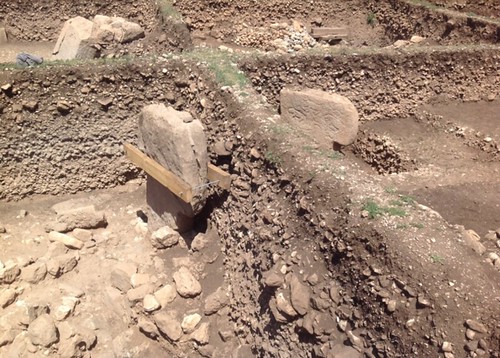
T-Shaped stone with a severe crack along the (probable) bedding plane. Courtesy K.G. Akoglu

Stone pillar with rounding at the corners, discoloration, biological deposition and pitting. Courtesy K.G. Akoglu
Special thanks to Dr. Lee Clare of the German Archaeological Institute, who reviewed this article for accuracy, and Dr. Kiraz Göze Akoglu, who prepared reports on the state of conservation at Göbekli Tepe.
About the Global Heritage Fund (GHF)
Global Heritage Fund’s mission is to sustainably preserve the most significant and endangered cultural heritage sites in developing regions of the world. With this mission, it also works to empower local communities through heritage preservation. Believing in a future that is beyond monuments, GHF partners with local people, communities, organizations, and governments to both preserve the heritage of the past and ensure that it is a beneficial part of the present.

